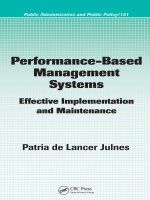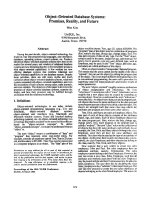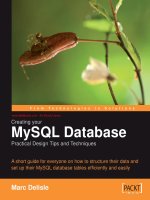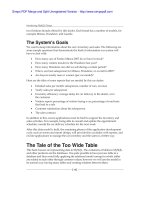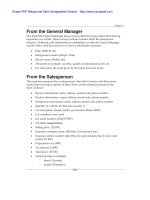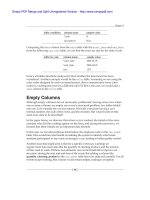database systems design, implementation, and management
Bạn đang xem bản rút gọn của tài liệu. Xem và tải ngay bản đầy đủ của tài liệu tại đây (22.68 MB, 724 trang )
DATABASE SYSTEMS
CARLOS CORONEL • STEVEN MORRIS • PETER ROB
DESIGN, IMPLEMENTATION, AND MANAGEMENT
Australia • Brazil • Japan • Korea • Mexico • Singapore • Spain • United Kingdom • United States
A_C7046_FM.4c 10/23/09 4:28 PM Page i
Copyright 2010 Cengage Learning. All Rights Reserved. May not be copied, scanned, or duplicated, in whole or in part.
Database Systems: Design, Implementation,
and Management, Ninth Edition
Carlos Coronel, Steven Morris, and Peter Rob
Vice President of Editorial, Business: Jack W. Calhoun
Publisher: Joe Sabatino
Senior Acquisitions Editor: Charles McCormick, Jr.
Senior Product Manager: Kate Mason
Development Editor: Deb Kaufmann
Editorial Assistant: Nora Heink
Senior Marketing Communications Manager:
Libby Shipp
Marketing Coordinator: Suellen Ruttkay
Content Product Manager: Matthew Hutchinson
Senior Art Director: Stacy Jenkins Shirley
Cover Designer: Itzhack Shelomi
Cover Image: iStock Images
Media Editor: Chris Valentine
Manufacturing Coordinator: Julio Esperas
Copyeditor: Andrea Schein
Proofreader: Foxxe Editorial
Indexer: Elizabeth Cunningham
Composition: GEX Publishing Services
©
2011 Cengage Learning
ALL RIGHTS RESERVED. No part of this work covered by the copyright herein may be
reproduced, transmitted, stored or used in any form or by any means graphic, electronic,
or mechanical, including but not limited to photocopying, recording, scanning, digitiz-
ing, taping, Web distribution, information networks, or information storage and retrieval
systems, except as permitted under Section
107 or 108 of the 1976 United States
Copyright Act, without the prior written permission of the publisher.
Library of Congress Control Number:
2009936830
Student Edition Package
ISBN-
13: 978-0-538-46968-5
ISBN-10: 0-538-46968-4
Student Edition (Book Only)
ISBN-
13: 978-0-538-74884-1
ISBN-10: 0-538-74884-2
Instructor Edition
ISBN-
13: 978-0-538-46806-0
ISBN-10: 0-538-46806-8
Cengage Learning
20 Channel Center Street
Boston, MA 02210
USA
Cengage Learning is a leading provider of customized learning solutions with office loca-
tions around the globe, including Singapore, the United Kingdom, Australia, Mexico,
Brazil, and Japan. Locate your local office at:
international.cengage.com/region
Cengage Learning products are represented in Canada by Nelson Education, Ltd.
To learn more about Course Technology, visit www.cengage.com/coursetechnology
To learn more about Cengage Learning, visit www.cengage.com.
Purchase any of our products at your local college store or at our preferred online store
www.ichapters.com
Printed in the United States of America
1 2 3 4 5 6 7 17 16 15 14 13 12 11
For product information and technology assistance, contact us at
Cengage Learning Customer & Sales Support,
1-800-354-9706
For permission to use material from this text or product, submit all
requests online at www.cengage.com/permissions
Further permissions questions can be emailed to
D
edication
To the treasures in my life:To Victoria, for 20 wonderful years.Thank you for your unending
support, for being my angel, my sweetie and most importantly, my best friend. To Carlos
Anthony whose intelligence and wit is matched only by your good looks; you show us the way.
Thank you for your words of wisdom, contagious happiness and for bringing us shining days.
You are still young; your best times are still to come.To Gabriela Victoria who is the image of
brilliance, beauty, and faithfulness. Thank you for being the sunshine in my cloudy days. To
Christian Javier whose endless energy and delightful smiles keep us going every day. Thank you
for being the youthful reminder of life’s simple beauties.To my parents, Sarah and Carlos, thank
you for your sacrifice and example.To all of you, you are all my inspiration.“TQTATA.”
Carlos Coronel
To Pamela, from high school sweetheart through 20 years of marriage, the beautiful love of
my life who has supported, encouraged, and inspired me. More than anyone else, you are
responsible for whatever successes I have achieved. To my son, Alexander Logan, whose
depth of character is without measure.You are my pride and joy. To my daughter, Lauren
Elizabeth, whose beauty and intensity take my breath away.You are my heart and soul.
Thank you all for the sacrifices that you have made that enabled me to pursue this dream.
I love you so much more than I can express.To my mother, Florence Maryann, and to the
memory of my father, Alton Lamar, who together instilled in me the desire to learn and the
passion to achieve.To my mother-in-law, Connie Duke, and to the memory of my father-in-
law, Wayne Duke, who taught me to find joy in all things.To all of you, with all my love,
I dedicate this book.
Steven Morris
To Anne, who remains my best friend after 48 years of marriage.To our son, Peter William,
who turned out to be the man we hoped he would be and who proved his wisdom by
making Sheena our treasured daughter-in-law. To Sheena, who stole our hearts so many
years ago.To our grandsons, Adam Lee and Alan Henri, who are growing up to be the fine
human beings their parents are.To my mother-in-law, Nini Fontein, and to the memory of
my father-in-law,Henri Fontein—their life experiences in Europe and Southeast Asia would
fill a history book and they enriched my life by entrusting me with their daughter’s future.
To the memory of my parents, Hendrik and Hermine Rob, who rebuilt their lives after
World War II’s horrors, who did it again after a failed insurgency in Indonesia, and who
finally found their promised land in these United States. And to the memory of Heinz, who
taught me daily lessons about loyalty, uncritical acceptance, and boundless understanding.
I dedicate this book to you, with love.
Peter Rob
DEDICATION
BRIEF CONTENTS
IV
PART I: Database Concepts
Chapter 1: Database Systems
Chapter 2: Data Models
PART II: Design Concepts
Chapter 3: The Relational Database Model
Chapter 4: Entity Relationship (ER) Modeling
Chapter 5: Advanced Data Modeling
Chapter 6: Normalization of Database Tables
PART III: Advanced Design and Implementation
Chapter 7: Introduction to Structured Query Language (SQL)
Chapter 8: Advanced SQL
Chapter 9: Database Design
PART IV: Advanced Database Concepts
Chapter 10: Transaction Management and Concurrency Control
Chapter 11: Database Performance Tuning and Query Optimization
Chapter 12: Distributed Database Management Systems
Chapter 13: Business Intelligence and Data Warehouses
PART V: Databases and the Internet
Chapter 14: Database Connectivity and Web Technologies
PART VI: Database Administration
Chapter 15: Database Administration and Security
GLOSSARY
INDEX
BRIEF CONTENTS
V
The following appendixes and answers to selected questions and problems are included in the Premium Website for
this text, found at cengage.com/mis/coronel.
Appendix A: Designing Databases with Visio Professional: A Tutorial
Appendix B: The University Lab: Conceptual Design
Appendix C:
The University Lab: Conceptual Design Verification, Logical
Design, and Implementation
Appendix D: Converting an ER Model into a Database Structure
Appendix E: Comparison of ER Model Notations
Appendix F: Client/Server Systems
Appendix G: Object-Oriented Databases
Appendix H: Unified Modeling Language (UML)
Appendix I: Databases in Electronic Commerce
Appendix J: Web Database Development with ColdFusion
Appendix K: The Hierarchical Database Model
Appendix L: The Network Database Model
Appendix M: Microsoft
®
Access
®
Tutorial
Appendix N: Creating a New Database Using Oracle 11g
Answers to Selected Questions and Problems
TABLE OF CONTENTS
VI
PART I DATABASE CONCEPTS
Business Vignette: The Relational Revolution 3
Chapter 1 Database Systems 4
1.1 Why Databases? 5
1.2 Data vs. Information 5
1.3 Introducing the Database 7
1.3.1 Role and Advantages of the DBMS 7
1.3.2 Types of Databases 9
1.4 Why Database Design is Important 10
1.5 Evolution of File System Data Processing 11
1.5.1 Manual File Systems 11
1.5.2 Computerized File Systems 11
1.5.3 File System Redux: Modern End-User Productivity Tools 14
1.6 Problems with File System Data Processing 14
1.6.1 Structural and Data Dependence 15
1.6.2 Data Redundancy 16
1.6.3 Lack of Design and Data-Modeling Skills 17
1.7 Database Systems 17
1.7.1 The Database System Environment 18
1.7.2 DBMS Functions 20
1.7.3 Managing the Database System: A Shift in Focus 23
Summary 25
Key Terms 25
Review Questions 26
Problems 26
Chapter 2 Data Models 29
2.1 Data Modeling and Data Models 30
2.2 The Importance of Data Models 30
2.3 Data Model Basic Building Blocks 31
2.4 Business Rules 32
2.4.1 Discovering Business Rules 33
2.4.2 Translating Business Rules into Data Model Components 33
2.4.3 Naming Conventions 34
2.5 The Evolution of Data Models 34
2.5.1 Hierarchical and Network Models 35
2.5.2 The Relational Model 36
2.5.3 The Entity Relationship Model 38
2.5.4 The Object-Oriented (OO) Model 40
2.5.5 Newer Data Models: Object/Relational and XML 42
2.5.6 The Future of Data Models 43
2.5.7 Data Models: A Summary 43
2.6 Degrees of Data Abstraction 46
2.6.1 The External Model 46
2.6.2 The Conceptual Model 48
2.6.3 The Internal Model 49
2.6.4 The Physical Model 49
TABLE OF CONTENTS
VII
Summary 51
Key Terms 51
Review Questions 52
Problems 53
PART II DESIGN CONCEPTS
Business Vignette: BP’s Data Modeling Initiative 61
Chapter 3 The Relational Database Model 58
3.1 A Logical View of Data 59
3.1.1 Tables and Their Characteristics 59
3.2 Keys 62
3.3 Integrity Rules 66
3.4 Relational Set Operators 68
3.5 The Data Dictionary and the System Catalog 74
3.6 Relationships within the Relational Database 76
3.6.1 The 1:M Relationship 76
3.6.2 The 1:1 Relationship 78
3.6.3 The M:N Relationship 78
3.7 Data Redundancy Revisited 84
3.8 Indexes 86
3.9 Codd’s Relational Database Rules 88
Summary 89
Key Terms 89
Review Questions 90
Problems 92
Chapter 4 Entity Relationship (ER) Modeling 99
4.1 The Entity Relationship Model (ERM) 100
4.1.1 Entities 100
4.1.2 Attributes 101
4.1.3 Relationships 105
4.1.4 Connectivity and Cardinality 107
4.1.5 Existence Dependence 108
4.1.6 Relationship Strength 108
4.1.7 Weak Entities 110
4.1.8 Relationship Participation 113
4.1.9 Relationship Degree 116
4.1.10 Recursive Relationships 117
4.1.11 Associative (Composite) Entities 121
4.2 Developing an ER Diagram 123
4.3 Database Design Challenges: Conflicting Goals 128
Summary 134
Key Terms 134
Review Questions 135
Problems 137
Cases 140
TABLE OF CONTENTS
VIII
Chapter 5 Advanced Data Modeling 147
5.1 The Extended Entity Relationship Model 148
5.1.1 Entity Supertypes and Subtypes 148
5.1.2 Specialization Hierarchy 149
5.1.3 Inheritance 150
5.1.4 Subtype Discriminator 151
5.1.5 Disjoint and Overlapping Constraints 151
5.1.6 Completeness Constraint 153
5.1.7 Specialization and Generalization 154
5.2 Entity Clustering 154
5.3 Entity Integrity: Selecting Primary Keys 155
5.3.1 Natural Keys and Primary Keys 156
5.3.2 Primary Key Guidelines 156
5.3.3 When to Use Composite Primary Keys 157
5.3.4 When to Use Surrogate Primary Keys 158
5.4 Design Cases: Learning Flexible Database Design 159
5.4.1 Design Case #1: Implementing 1:1 Relationships 160
5.4.2 Design Case #2: Maintaining History of Time-Variant Data 161
5.4.3 Design Case #3: Fan Traps 162
5.4.4 Design Case #4: Redundant Relationships 164
Summary 165
Key Terms 165
Review Questions 166
Problems 167
Cases 168
Chapter 6 Normalization of Database Tables 174
6.1 Database Tables and Normalization 175
6.2 The Need for Normalization 175
6.3 The Normalization Process 179
6.3.1 Conversion to First Normal Form 181
6.3.2 Conversion to Second Normal Form 184
6.3.3 Conversion to Third Normal Form 185
6.4 Improving the Design 187
6.5 Surrogate Key Considerations 191
6.6 Higher-Level Normal Forms 192
6.6.1 The Boyce-Codd Normal Form (BCNF) 192
6.6.2 Fourth Normal Form (4NF) 196
6.7 Normalization and Database Design 197
6.8 Denormalization 200
6.9 Data-Modeling Checklist 204
Summary 206
Key Terms 206
Review Questions 207
Problems 208
TABLE OF CONTENTS
IX
PART III ADVANCED DESIGN AND IMPLEMENTATION
Business Vignette: The Many Benefits of BI 219
Chapter 7 Introduction to Structured Query Language (SQL) 220
7.1 Introduction to SQL 221
7.2 Data Definition Commands 223
7.2.1 The Database Model 223
7.2.2 Creating the Database 225
7.2.3 The Database Schema 225
7.2.4 Data Types 226
7.2.5 Creating Table Structures 229
7.2.6 SQL Constraints 232
7.2.7 SQL Indexes 235
7.3 Data Manipulation Commands 237
7.3.1 Adding Table Rows 237
7.3.2 Saving Table Changes 238
7.3.3 Listing Table Rows 238
7.3.4 Updating Table Rows 240
7.3.5 Restoring Table Contents 240
7.3.6 Deleting Table Rows 241
7.3.7 Inserting Table Rows with a Select Subquery 242
7.4 SELECT Queries 242
7.4.1 Selecting Rows with Conditional Restrictions 242
7.4.2 Arithmetic Operators:The Rule of Precedence 247
7.4.3 Logical Operators: AND, OR, and NOT 247
7.4.4 Special Operators 249
7.5 Additional Data Definition Commands 253
7.5.1 Changing a Column’s Data Type 253
7.5.2 Changing a Column’s Data Characteristics 254
7.5.3 Adding a Column 254
7.5.4 Dropping a Column 255
7.5.5 Advanced Data Updates 255
7.5.6 Copying Parts of Tables 257
7.5.7 Adding Primary and Foreign Key Designations 258
7.5.8 Deleting a Table from the Database 259
7.6 Additional SELECT Query Keywords 259
7.6.1 Ordering a Listing 259
7.6.2 Listing Unique Values 261
7.6.3 Aggregate Functions 261
7.6.4 Grouping Data 266
7.7 Virtual Tables: Creating a View 269
7.8 Joining Database Tables 270
7.8.1 Joining Tables with an Alias 273
7.8.2 Recursive Joins 273
7.8.3 Outer Joins 274
Summary 276
Key Terms 277
Review Questions 277
Problems 278
Cases 287
TABLE OF CONTENTS
X
Chapter 8 Advanced SQL 297
8.1 Relational Set Operators 298
8.1.1 UNION 299
8.1.2 UNION ALL 300
8.1.3 INTERSECT 300
8.1.4 MINUS 301
8.1.5 Syntax Alternatives 303
8.2 SQL Join Operators 305
8.2.1 Cross Join 306
8.2.2 Natural Join 307
8.2.3 Join USING Clause 307
8.2.4 JOIN ON Clause 308
8.2.5 Outer Joins 309
8.3 Subqueries and Correlated Queries 312
8.3.1 WHERE Subqueries 314
8.3.2 IN Subqueries 315
8.3.3 HAVING Subqueries 316
8.3.4 Multirow Subquery Operators: ANY and ALL 317
8.3.5 FROM Subqueries 318
8.3.6 Attribute List Subqueries 319
8.3.7 Correlated Subqueries 321
8.4 SQL Functions 324
8.4.1 Date and Time Functions 324
8.4.2 Numeric Functions 327
8.4.3 String Functions 327
8.4.4 Conversion Functions 328
8.5 Oracle Sequences 330
8.6 Updatable Views 333
8.7 Procedural SQL 336
8.7.1 Triggers 341
8.7.2 Stored Procedures 350
8.7.3 PL/SQL Processing with Cursors 354
8.7.4 PL/SQL Stored Functions 357
8.8 Embedded SQL 358
Summary 363
Key Terms 364
Review Questions 364
Problems 365
Cases 369
Chapter 9 Database Design 372
9.1 The Information System 373
9.2 The Systems Development Life Cycle (SDLC) 375
9.2.1 Planning 376
9.2.2 Analysis 376
9.2.3 Detailed Systems Design 377
9.2.4 Implementation 377
9.2.5 Maintenance 377
9.3 The Database Life Cycle (DBLC) 378
9.3.1 The Database Initial Study 378
9.3.2 Database Design 382
TABLE OF CONTENTS
XI
9.3.3 Implementation and Loading 384
9.3.4 Testing and Evaluation 386
9.3.5 Operation 389
9.3.6 Maintenance and Evolution 389
9.4 Conceptual Design 390
9.4.1 Data Analysis and Requirements 391
9.4.2 Entity Relationship Modeling and Normalization 393
9.4.3 Data Model Verification 396
9.4.4 Distributed Database Design 399
9.5 DBMS Software Selection 399
9.6 Logical Design 400
9.6.1 Map the Conceptual Model to the Logical Model 400
9.6.2 Validate the Logical Model Using Normalization 402
9.6.3 Validate Logical Model Integrity Constraints 402
9.6.4 Validate the Logical Model against User Requirements 403
9.7 Physical Design 403
9.7.1 Define Data Storage Organization 403
9.7.2 Define Integrity and Security Measures 404
9.7.3 Determine Performance Measures 404
9.8 Database Design Strategies 405
9.9 Centralized vs. Decentralized Design 406
Summary 409
Key Terms 409
Review Questions 410
Problems 410
PART IV ADVANCED DATABASE CONCEPTS
Business Vignette: Combating Data Explosion 413
Chapter 10 Transaction Management and Concurrency Control 414
10.1 What Is a Transaction? 415
10.1.1 Evaluating Transaction Results 416
10.1.2 Transaction Properties 419
10.1.3 Transaction Management with SQL 419
10.1.4 The Transaction Log 420
10.2 Concurrency Control 421
10.2.1 Lost Updates 422
10.2.2 Uncommitted Data 423
10.2.3 Inconsistent Retrievals 424
10.2.4 The Scheduler 425
10.3 Concurrency Control with Locking Methods 426
10.3.1 Lock Granularity 427
10.3.2 Lock Types 430
10.3.3 Two-Phase Locking to Ensure Serializability 431
10.3.4 Deadlocks 432
10.4 Concurrency Control with Time Stamping Methods 433
10.4.1 Wait/Die and Wound/Wait Schemes 434
TABLE OF CONTENTS
XII
10.5 Concurrency Control with Optimistic Methods 435
10.6 Database Recovery Management 435
10.6.1 Transaction Recovery 436
Summary 440
Key Terms 441
Review Questions 441
Problems 442
Chapter 11 Database Performance Tuning and Query Optimization 445
11.1 Database Performance-Tuning Concepts 446
11.1.1 Performance Tuning: Client and Server 447
11.1.2 DBMS Architecture 447
11.1.3 Database Statistics 449
11.2 Query Processing 451
11.2.1 SQL Parsing Phase 452
11.2.2 SQL Execution Phase 453
11.2.3 SQL Fetching Phase 453
11.2.4 Query Processing Bottlenecks 453
11.3 Indexes and Query Optimization 454
11.4 Optimizer Choices 456
11.4.1 Using Hints to Affect Optimizer Choices 458
11.5 SQL Performance Tuning 459
11.5.1 Index Selectivity 459
11.5.2 Conditional Expressions 460
11.6 Query Formulation 462
11.7 DBMS Performance Tuning 463
11.8 Query Optimization Example 465
Summary 474
Key Terms 475
Review Questions 475
Problems 476
Chapter 12 Distributed Database Management Systems 480
12.1 The Evolution of Distributed Database Management Systems 481
12.2 DDBMS Advantages and Disadvantages 483
12.3 Distributed Processing and Distributed Databases 484
12.4 Characteristics of Distributed Database Management Systems 485
12.5 DDBMS Components 486
12.6 Levels of Data and Process Distribution 488
12.6.1 Single-Site Processing, Single-Site Data (SPSD) 488
12.6.2 Multiple-Site Processing, Single-Site Data (MPSD) 489
12.6.3 Multiple-Site Processing, Multiple-Site Data (MPMD) 490
12.7 Distributed Database Transparency Features 491
12.8 Distribution Transparency 492
12.9 Transaction Transparency 494
12.9.1 Distributed Requests and Distributed Transactions 494
12.9.2 Distributed Concurrency Control 498
12.9.3 Two-Phase Commit Protocol 498
TABLE OF CONTENTS
XIII
12.10 Performance Transparency and Query Optimization 499
12.11 Distributed Database Design 501
12.11.1 Data Fragmentation 501
12.11.2 Data Replication 504
12.11.3 Data Allocation 506
12.12 Client/Server vs. DDBMS 507
12.13 C. J. Date’s Twelve Commandments for Distributed Databases 508
Summary 509
Key Terms 510
Review Questions 510
Problems 511
Chapter 13 Business Intelligence and Data Warehouses 514
13.1 The Need for Data Analysis 515
13.2 Business Intelligence 515
13.3 Business Intelligence Architecture 517
13.4 Decision Support Data 521
13.4.1 Operational Data vs. Decision Support Data 521
13.4.2 Decision Support Database Requirements 523
13.5 The Data Warehouse 526
13.5.1 Twelve Rules that Define a Data Warehouse 528
13.5.2 Decision Support Architectural Styles 529
13.6 Online Analytical Processing 529
13.6.1 Multidimensional Data Analysis Techniques 529
13.6.2 Advanced Database Support 533
13.6.3 Easy-to-Use End-User Interface 533
13.6.4 Client/Server Architecture 533
13.6.5 OLAP Architecture 533
13.6.6 Relational OLAP 537
13.6.7 Multidimensional OLAP 539
13.6.8 Relational vs. Multidimensional OLAP 540
13.7 Star Schemas 541
13.7.1 Facts 541
13.7.2 Dimensions 542
13.7.3 Attributes 542
13.7.4 Attribute Hierarchies 544
13.7.5 Star Schema Representation 545
13.7.6 Performance-Improving Techniques for the Star Schema 548
13.8 Implementing a Data Warehouse 551
13.8.1 The Data Warehouse as an Active Decision Support Framework 551
13.8.2 A Company-Wide Effort that Requires User Involvement 552
13.8.3 Satisfy the Trilogy: Data,Analysis, and Users 552
13.8.4 Apply Database Design Procedures 552
13.9 Data Mining 553
13.10 SQL Extensions for OLAP 556
13.10.1 The ROLLUP Extension 557
13.10.2 The CUBE Extension 558
13.10.3 Materialized Views 559
Summary 564
Key Terms 565
Review Questions 565
Problems 566
TABLE OF CONTENTS
XIV
PART V DATABASES AND THE INTERNET
Business Vignette: KBB Transforms with Innovative Web Services 573
Chapter 14 Database Connectivity and Web Technologies 574
14.1 Database Connectivity 575
14.1.1 Native SQL Connectivity 575
14.1.2 ODBC, DAO, and RDO 575
14.1.3 OLE-DB 579
14.1.4 ADO.NET 581
14.1.5 Java Database Connectivity (JDBC) 583
14.2 Internet Databases 585
14.2.1 Web-to-Database Middleware: Server-Side Extensions 586
14.2.2 Web Server Interfaces 588
14.2.3 The Web Browser 589
14.2.4 Client-Side Extensions 590
14.2.5 Web Application Servers 591
14.3 Extensible Markup Language (XML) 592
14.3.1 Document Type Definitions (DTD) and XML Schemas 594
14.3.2 XML Presentation 596
14.3.3 XML Applications 597
14.4 SQL Data Services 600
Summary 602
Key Terms 603
Review Questions 603
Problems 604
PART VI DATABASE ADMINISTRATION
Business Vignette: The Rising SQL Injection Threat 607
Chapter 15 Database Administration and Security 608
15.1 Data as a Corporate Asset 609
15.2 The Need for and Role of a Database in an Organization 610
15.3 Introduction of a Database: Special Considerations 612
15.4 The Evolution of the Database Administration Function 613
15.5 The Database Environment’s Human Component 616
15.5.1 The DBA’s Managerial Role 618
15.5.2 The DBA’s Technical Role 623
15.6 Security 629
15.6.1 Security Policies 629
15.6.2 Security Vulnerabilities 630
15.6.3 Database Security 631
15.7 Database Administration Tools 633
15.7.1 The Data Dictionary 633
15.7.2 CASE Tools 635
TABLE OF CONTENTS
XV
15.8 Developing a Data Administration Strategy 637
15.9 The DBA at Work: Using Oracle for Database Administration 639
15.9.1 Oracle Database Administration Tools 640
15.9.2 The Default Login 640
15.9.3 Ensuring an Automatic RDBMS Start 641
15.9.4 Creating Tablespaces and Datafiles 642
15.9.5 Managing the Database Objects:Tables,Views,Triggers, and Procedures 643
15.9.6 Managing Users and Establishing Security 644
15.9.7 Customizing the Database Initialization Parameters 647
Summary 648
Key Terms 649
Review Questions 649
Glossary 653
Index 672
IN THE PREMIUM WEBSITE
The Premium Website can be found at cengage.com/mis/coronel. Locate your premium access card in the front of each new
book purchase, and click “Create My Account” to begin the registration process. If you’ve purchased a used book, please
search for Database Systems, Ninth Edition at www.ichapters.com where you can purchase instant access.
Appendix A Designing Databases with Visio Professional: A Tutorial
Appendix B The University Lab: Conceptual Design
Appendix C The University Lab: Conceptual Design Verification, Logical Design,
and Implementation
Appendix D Converting an ER Model into a Database Structure
Appendix E Comparison of ER Model Notations
Appendix F Client/Server Systems
Appendix G Object-Oriented Databases
Appendix H Unified Modeling Language (UML)
Appendix I Databases in Electronic Commerce
Appendix J Web Database Development with ColdFusion
Appendix K The Hierarchical Database Model
Appendix L The Network Database Model
Appendix M Microsoft® Access® Tutorial
Appendix N Creating a New Database with Oracle 11g
Answers to Selected Questions and Problems
PREFACE
XVI
This database systems book has been successful through eight editions because the authors, editors, and the publisher
paid attention to the impact of technology and to adopter questions and suggestions.We believe that this ninth edition
successfully reflects the same attention to such stimuli. Furthermore this ninth edition marks the addition of a new
co-author, Steven Morris. Steven brings his wealth of knowledge, teaching experience, and expertise to this work.
In many respects, rewriting a book is more difficult than writing it the first time. If the book is successful, as this one is,
a major concern is that the updates, inserts, and deletions will adversely affect writing style and continuity of coverage.
Fortunately, this edition benefits from the incorporation of a new co-author with fresh ideas and perspectives balanced
by the experience of the original authors to ensure continuity of writing style and quality of presentation.In addition, the
efforts of a combination of superb reviewers and editors, plus a wealth of feedback from adopters and students of the
previous editions, helped provide the guidance that make this new edition the best yet.
XVII
CHANGES TO THE NINTH EDITION
In this ninth edition, we have added some new features and we have reorganized some of the coverage to provide a
better flow of material. Aside from enhancing the already strong database design coverage, we have made other
improvements in the topical coverage. Here are a few of the highlights:
• Updated Business Vignettes showing the impact of database technologies in the real world.
• Strengthened the database design contents by more clearly differentiating among the conceptual, logi-
cal, and physical design stages.
• Streamlined and modernized the coverage of database evolution and the importance of database design
skills.
• Enhanced the coverage of data models by shifting the focus from a historical perspective to emerging
data technologies.
• Expanded end-of-chapter review questions and problems and introduced a new Cases section to
selected chapters.
• Formalized and improved consistency of normalization concepts.
• Improved readability and overall visual appeal of the book.
• Created a database design process guide and a data modeling checklist as cover inserts.
This ninth edition continues to provide a solid and practical foundation for the design, implementation, and manage-
ment of database systems. This foundation is built on the notion that, while databases are very practical things, their
successful creation depends on understanding the important concepts that define them. It’s not easy to come up with
the proper mix of theory and practice, but we are grateful that the previously mentioned feedback suggests that we
largely succeeded in our quest to maintain the proper balance.
THE APPROACH: A CONTINUED EMPHASIS ON DESIGN
As the title suggests, Database Systems: Design, Implementation, and Management covers three broad aspects of
database systems. However, for several important reasons, special attention is given to database design.
• The availability of excellent database software enables even database-inexperienced people to create
databases and database applications. Unfortunately, the “create without design” approach usually
paves the road to any number of database disasters. In our experience, many, if not most, database sys-
tem failures are traceable to poor design and cannot be solved with the help of even the best program-
mers and managers. Nor is better DBMS software likely to overcome problems created or magnified by
poor design. Using an analogy, even the best bricklayers and carpenters can’t create a good building
from a bad blueprint.
• Most of the vexing database system management problems seem to be triggered by poorly designed data-
bases. It hardly seems worthwhile to use scarce resources to develop excellent and extensive database sys-
tem management skills in order to exercise them on crises induced by poorly designed databases.
• Design provides an excellent means of communication. Clients are more likely to get what they need
when database system design is approached carefully and thoughtfully. In fact, clients may discover
how their organizations really function once a good database design is completed.
PREFACE
XVIII
• Familiarity with database design techniques promotes one’s understanding of current database tech-
nologies. For example, because data warehouses derive much of their data from operational databases,
data warehouse concepts, structures, and procedures make more sense when the operational data-
base’s structure and implementation are understood.
Because the practical aspects of database design are stressed, we have covered design concepts and procedures in
detail, making sure that the numerous end-of-chapter problems and cases are sufficiently challenging so students can
develop real and useful design skills. We also make sure that students understand the potential and actual conflicts
between database design elegance, information requirements, and transaction processing speed. For example, it
makes little sense to design databases that meet design elegance standards while they fail to meet end-user information
requirements. Therefore, we explore the use of carefully defined trade-offs to ensure that the databases are capable of
meeting end-user requirements while conforming to high design standards.
TOPICAL COVERAGE
The Systems View
The book’s title begins with Database Systems. Therefore, we examine the
database and design concepts covered in Chapters 1–6 as part of a larger
whole by placing them within the systems analysis framework of Chapter 9.
We believe that database designers who fail to understand that the database
is part of a larger system are likely to overlook important database design
requirements. In fact, Chapter 9, Database Design, provides the map for
the advanced database design developed in Appendixes B and C. Within
the larger systems framework, we can also explore issues such as transac-
tion management and concurrency control (Chapter 10), distributed data-
base management systems (Chapter 12), business intelligence and data
warehouses (Chapter 13), database connectivity and Web technologies
(Chapter 14), and database administration and security (Chapter 15).
Database Design
The first item in the
book’s subtitle is Design,
and our examination of
database design is com-
prehensive. For example, Chapters 1 and 2 examine the development
and future of databases and data models and illustrate the need for
design. Chapter 3 examines the details of the relational database
model; Chapter 4 provides extensive, in-depth, and practical database
design coverage; and Chapter 5 explores advanced database design
topics. Chapter 6 is devoted to critical normalization issues that affect
database efficiency and effectiveness. Chapter 9 examines database
design within the systems framework and maps the activities required
to successfully design and implement the complex real-world database
PREFACE
XIX
developed in Appendixes B and C. Appendix A, Designing Databases with Visio Professional: A Tutorial, provides a
good introductory tutorial for the use of a database design tool.
Because database design is affected by real-world transactions, the way data are distributed, and ever-increasing
information requirements, we examine major database features that must be supported in current-generation data-
bases and models. For example, Chapter 10, Transaction Management and Concurrency Control, focuses on the
characteristics of database transactions and how they affect database integrity and consistency. Chapter 11,
Database Performance Tuning and Query Optimization, illustrates the need for query efficiency in a real world that
routinely generates and uses terabyte-sized databases and tables with millions of records. Chapter 12, Distributed
Database Management Systems, focuses on data distribution, replication, and allocation. In Chapter 13, Business
Intelligence and Data Warehouses, we explore the characteristics of the databases that are used in decision support
and online analytical processing. Chapter 14, Database Connectivity and Web Technologies, covers the basic data-
base connectivity issues encountered in a Web-based data world, and it shows the development of Web-based data-
base front ends.
Implementation
The second portion of the subtitle is Implementation. We use Structured
Query Language (SQL) in Chapters 7 and 8 to show how databases are
implemented and managed. Appendix M, Microsoft Access Tutorial, pro-
vides a quick but comprehensive guide to MS Access database implemen-
tation. Appendixes B and C demonstrate the design of a database that was
fully implemented and they illustrate a wide range of implementation
issues. We had to deal with conflicting design goals: design elegance, infor-
mation requirements, and operational speed. Therefore, we carefully
audited the initial design (Appendix B) to check its ability to meet end-user
needs and to establish appropriate implementation protocols. The result of
this audit yielded the final, implementable design developed in Appendix
C. The special issues encountered in an Internet database environment are
addressed in Chapter 14, Database Connectivity and Web Technologies,
and in Appendix J, Web
Database Development
with ColdFusion.
Management
The final portion of the subtitle is Management. We deal with database
management issues in Chapter 10, Transaction Management and
Concurrency Control; Chapter 12, Distributed Database Management
Systems; and Chapter 15, Database Administration and Security.
Chapter 11, Database Performance Tuning and Query Optimization, is
a valuable resource that illustrates how a DBMS manages the data
retrieval operations. In addition, Appendix N, Creating a New Database
Using Oracle 11g, walks you through the process of setting up a new
database.
PREFACE
XX
TEACHING DATABASE: A MATTER OF FOCUS
Given the wealth of detailed coverage, instructors can “mix and match” chapters to produce the desired coverage.
Depending on where database courses fit into the curriculum, instructors may choose to emphasize database design or
database management. (See Figure 1.)
The hands-on nature of database design lends itself particularly well to class projects for which students use instructor-
selected software to prototype a student-designed system for the end user. Several of the end-of-chapter problems are
sufficiently complex to serve as projects, or an instructor may work with local businesses to give students hands-on
experience. Note that some elements of the database design track are also found in the database management track.
This is because it is difficult to manage database technologies that are not understood.
The options shown in Figure 1 serve only as a starting point. Naturally, instructors will tailor their coverage based on
their specific course requirements. For example, an instructor may decide to make Appendix I an outside reading
assignment and Appendix A a self-taught tutorial, then use that time to cover client/server systems or object-oriented
databases. The latter choice would serve as a gateway to UML coverage.
FIGURE
1
(1) Database Systems
(2) Data Models
(3) The Relational Database Model
(4) Entity Relationship (ER) Modeling
(6) Normalization of Database Tables
(7) Introduction to Structured Query Language (SQL)
(10) Transaction Management and Concurrency Control
(11) Database Performance Tuning and Query Optimization
(12) Distributed Database Management Systems
(13) The Data Warehouse
(15) Database Administration
(F) Client/Server Systems
(G) Object-Oriented Databases
(I) Databases in Electronic Commerce
(9) Database Design
(A) Designing Databases with Visio Professional: A Tutorial
(D) Converting an ER Model into a Database Structure
(E) Comparison of ER Model Notations
(K) The Hierarchical Database Model
(L) The Network Database Model
(N) Creating a New Database Using Oracle 11g
(5) Advanced Data Modeling
(8) Advanced SQL
(9) Database Design
(D) Converting an ER Model into a Database Structure
(E) Comparison of ER Model Notations
(H) Unified Modeling Language (UML)
(11) Database Performance Tuning and Query Optimization
(14) Database Connectivity and Web Development
(J) Web Database Development with ColdFusion
(A) Designing Databases with Visio Professional: A Tutorial
(B) The University Lab: Conceptual Design
(C) The University Lab: Conceptual Design Verification,
Logical Design, and Implementation
(F) Client/Server Systems
(L) The Network Database Model
(M) Microsoft Access Tutorial
Core Coverage
Database Design and Implementation Focus Database Management Focus
Supplementary Reading Supplementary Reading
PREFACE
XXI
FIGURE
1.9
Illustrating data storage management with Oracle
The ORALAB database is
actually stored in nine
datafiles located on the C:
drive of the database server
computer.
The Oracle DBA Studio
Management interface also
shows the amount of space
used by each of the datafiles
that constitute the single
logical database.
Database Name: ORALAB.MTSU.EDU
The Oracle DBA Studio Administrator GUI shows the data storage
management characteristics for the ORALAB database.
Note
Data that display data inconsistency are also referred to as data that lack data integrity. Data integrity is defined
as the condition in which all of the data in the database are consistent with the real-world events and conditions.
In other words, data integrity means that:
•
Data are accurate—there are no data inconsistencies.
•
Data are verifiable—the data will always yield consistent results.
Online Content boxes
draw attention to material
in the Premium Website
for this text and provide
ideas for incorporating
this content into the course.
Business Vignettes
highlight part topics in
a real-life setting.
Notes highlight impor-
tant facts about the con-
cepts introduced in the
chapter.
A variety of four-color
figures, including ER
models and implementa-
tions, tables, and illustra-
tions, clearly illustrate
difficult concepts.
Online Content
The databases used in each chapter are available in the Premium Website for this book. Throughout the book,
Online Content boxes highlight material related to chapter content located in the Premium Website.
B
V
usiness
ignette
The Relational Revolution
Today, we take for granted the benefits brought to us by relational databases: the ability
to store, access, andchange data quickly and easily on low-cost computers.Yet, until the
late 1970s, databases stored largeamounts of data in a hierarchical structure that was
difficult to navigate andinflexible. Programmers needed to know what clients wanted to
do with the data before the database was designed. Adding or changing the way the data
was analyzed was a time-consuming and expensive process. As a resu
lt, you searched
throughhuge card catalogstofind a library book, youused road maps that didnt show
changes made in the last year, andyou had to buyanewspaper to findinformation on
stock prices.
In 1970, Edgar “Te d ” Codd, a mathematician employed by IBM, wrote an article that
would change all that. At the time, nobody realized that Codd’s obscure theories would
TEXT FEATURES
TEXT FEATURES
XXII
Summary
The ERM uses ERDs to represent the conceptual database as viewed by the end user. The ERM’s main components
are entities, relationships, and attributes. The ERD also includes connectivity and cardinality notations. An ERD can
also show relationship strength, relationship participation (optional or mandatory), and degree of relationship
(unary, binary, ternary, etc.).
Connectivity describes the relationship classification (1:1, 1:M, or M:N). Cardinality expresses the specific number
of entity occurrences associated with an occurrence of a related entity. Connectivities and cardinalities are usually
based on business rules.
In the ERM, a M:N relationship is valid at the conceptual level. However, when implementing the ERM ina
relational database, the M:N relationship must be mapped to a set of 1:M relationships through a composite entity.
Key Terms
binary relationship, 118
cardinality, 109
composite attribute, 105
composite key, 105
derived attribute, 107
existence-dependent, 110
identifying relationship, 112
iterative process, 124
mandatory participation, 116
multivalued attribute, 106
non-identifying relationship, 111
optional participation, 116
relationship degree, 118
simple attribute, 106
single-valued attribute, 106
strong relationship, 112
ternary relationship, 118
unary relati
onship, 118
Review Questions
1. What two conditions must be met before an entity can be classified as a weak entity? Give an example of a
weak entity.
2. What is a strong (or identifying) relationship, and how is it depicted in a Crow’s Foot ERD?
3. Given the business rule “an employee may have many degrees,” discuss its effect on attributes, entities, and
relationships. (Hint: Remember what a multivalued attribute is and how itmight be implemented.)
4. What is a composite entity, and when is it used?
5. Suppose you are working within the framework of the conceptual model inFigure Q4.5.
Problems
1. Given the following business rules, create the appropriate Crow’s Foot ERD.
a. A company operates many departments.
b. Each department employs one or more employees.
c. Each of the employees may or may not have one or more dependents.
d. Each employee may or may not have an employment history.
2. The Hudson Engineering Group (HEG) has contacted you to create a conceptual model whose application will
meet the expected database requirements for the company’s training program. The HEG administrator gives you
A robust Summary at
the end of each chap-
ter ties together the
major concepts and
serves as a quick
review for students.
Review Questions
challenge students to
apply the skills learned
in each chapter.
Problems become
progressively more
complex as students
draw on the lessons
learned from the com-
pletion of preceding
problems.
An alphabetic list of
Key Terms points to
the pages where terms
are first explained.
ADDITIONAL FEATURES
XXIII
PREMIUM WEBSITE
Single Sign On (SSO) provides a central location from which you can access Cengage Learning’s online learning solu-
tions with convenience and flexibility. You can:
• Gain access to online resources including robust Premium Website.
• Simplify your coursework by reducing human error and the need to keep track of multiple passwords.
See the insert card at the front of this book for instructions on how to access this text’s SSO site.
This Web resource, which you will find referenced throughout the book in the Online Content boxes, includes the fol-
lowing features:
Appendixes
Fourteen appendixes provide additional material on a variety of important areas, such as using Microsoft
®
Visio
®
and
Microsoft
®
Access
®
, ER model notations, UML, object-oriented databases, databases and electronic commerce, and
Adobe
®
ColdFusion
®
.
Answers to Selected Questions and Problems
The authors have provided answers to selected Review Questions and Problems from each chapter to help students
check their comprehension of chapter content and database skills.
Database, SQL Script, and ColdFusion Files
The Premium Website for this book includes all of the database structures and table contents used in the text. For students
using Oracle
®
and Microsoft SQL Server
™
, the SQL scripts to create and load all tables used in the SQL chapters (7 and 8)
are included. In addition, all ColdFusion scripts used to develop the Web interfaces shown Appendix J are included.
Video Tutorials
Custom-made video tutorials by Peter Rob and Carlos Coronel, exclusive to this textbook, provide clear explanations
of the essential concepts presented in the book. These unique tutorials will help the user gain a better understanding of
topics such as SQL, Oracle, ERDs, and ColdFusion.
Test Yourself on Database Systems
Brand new quizzes, created specifically for this site, allow users to test themselves on the content of each chapter and
immediately see what answers they answered right and wrong. For each question answered incorrectly, users are pro-
vided with the correct answer and the page in the text where that information is covered. Special testing software ran-
domly compiles a selection of questions from a large database, so students can take quizzes multiple times on a given
chapter, with some new questions each time.
Microsoft PowerPoint
®
Slides
Direct access is offered to the book’s PowerPoint presentations that cover the key points from each chapter. These
presentations are a useful study tool.
Useful Web Links
Students can access a chapter-by-chapter repository of helpful and relevant links for further research.
Glossary of Key Terms
Students can view a PDF file of the glossary from the book. They can also search for keywords and terms in this file;
it’s quick and easy to use!
Q & A
Helpful question-and-answer documents are available for download. Here you will find supporting material in areas
such as Data Dependency/Structural Dependency and Weak Entities/Strong Relationships.

